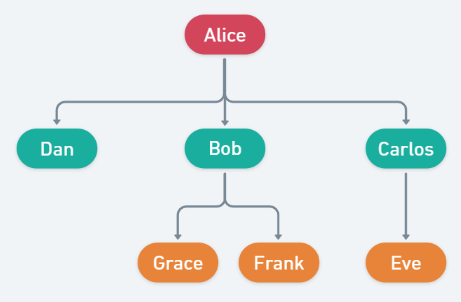Group-based data access
You can secure your data by using groups to define data access.
Any entity that has data is an object. Examples of objects are leads, activities, partners, calendar events, or branches. Access to objects in the Vymo app is determined by two things: reporting hierarchy and group-based access.
Consider a team of seven people, namely, Alice, Bob, Carlos, Dan, Eve, Frank, and Grace. Assume that they have a reporting hierarchy as follows:
- Bob, Carlos, and Dan report to Alice
- Grace and Frank report to Bob
- Eve reports to Carlos
- No one reports to Dan

In a system that uses only reporting-hierarchy-based data access, Bob can access all objects that are assigned to Grace and Frank. However, Bob can't access the objects assigned to Eve, because Eve doesn't report to Bob. There might, however, be scenarios where the following kind of access is needed:
- Bob needs to see the objects assigned to Eve
- Bob needs to see Eve, but not the objects assigned to her
To meet this requirement of additional access that works in parallel with access through reporting hierarchy, group-based access is used in the Vymo app. Data access can happen in two ways:
- By access to the data itself. In the described scenario, objects assigned to Eve can be put into a group, and Bob given access to that group.
- By access to a person who has access to that data. This can happen in the following two ways:
- By direct access to a user. In the described scenario, Bob can be given access to Eve. When this happens, Bob can see the objects assigned to Eve.
- By access to a group of which the user is a member. In the described scenario, if Eve is a member of a group called
North Officeand Bob is authorized to see theNorth Officegroup, Bob can see the objects assigned to all members of theNorth Officegroup.
None of these options have any effect on reporting hierarchy.
Groups can also have hierarchies. Group hierarchies work like reporting hierarchies; if someone is given authorized access to a group, the authorization extends to its child groups also.
Implementing group-based access
To implement group-based access, contact Vymo Support.
Questions and answers
- I have authorized access to the objects of Group A, but my manager doesn't. Can my manager see the objects of Group A?
- Yes. Your manager can see all objects that are assigned to you, and all objects that you are authorized to access.
- I am a member of a group. Can other members of the group see the objects that I have access to?
- Not always. A member of that group can see your objects only if you report to that person. Normally, each person sees only their own objects unless the group itself is given explicit access to itself, in which case members of the group can see objects assigned to other members of the group.